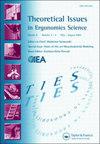2SAFE: a health belief model-integrated framework for participatory ergonomics
IF 1.4
Q4 ERGONOMICS
引用次数: 2
Abstract
Abstract Initiating ergonomics interventions in a business environment requires changes in the behaviour of relevant actors. When participating in an intervention, researchers need to collect and share information with practitioners to help them make better behaviour-related decisions. This paper describes the five-step 2SAFE (Surveillance, Screening, Assessment, Framing, and Evaluation) planning framework, which can be used to guide research-practice collaboration in participatory ergonomics programmes. This framework combines the understanding of work-related musculoskeletal disorders with the principles of the health belief model. This theoretical synthesis empowers the framework to address the following critical challenges: (1) how to make data collection processes attuned to the nature of ergonomic injuries; and (2) how to transform the data collected into immediately usable information for practitioners to change their behaviours. The framework is interdisciplinary and can facilitate transfer of knowledge between ergonomics and health behaviour science. The framework can enhance the ability of researchers to collaborate with practitioners and bring participatory ergonomics programmes closer to success. In the long term, we hope that this framework can lead to more high-quality interventions that are able to prevent work-related musculoskeletal disorders in various industrial settings.2SAFE:一个参与人体工程学的健康信念模型集成框架
在商业环境中启动人体工程学干预需要改变相关参与者的行为。在参与干预时,研究人员需要收集并与从业者分享信息,以帮助他们做出更好的与行为相关的决策。本文描述了五步2SAFE(监测、筛选、评估、框架和评估)规划框架,该框架可用于指导参与式人体工程学项目的研究-实践合作。该框架将对与工作相关的肌肉骨骼疾病的理解与健康信念模型的原则相结合。这一理论综合使框架能够解决以下关键挑战:(1)如何使数据收集过程适应人体工程学损伤的性质;(2)如何将收集到的数据转化为从业者可以立即使用的信息,以改变他们的行为。该框架是跨学科的,可以促进人体工程学和健康行为科学之间的知识转移。该框架可以提高研究人员与实践者合作的能力,使参与式人体工程学方案更接近成功。从长远来看,我们希望这一框架能够带来更多高质量的干预措施,能够在各种工业环境中预防与工作相关的肌肉骨骼疾病。
本文章由计算机程序翻译,如有差异,请以英文原文为准。
求助全文
约1分钟内获得全文
求助全文

 求助内容:
求助内容: 应助结果提醒方式:
应助结果提醒方式:


